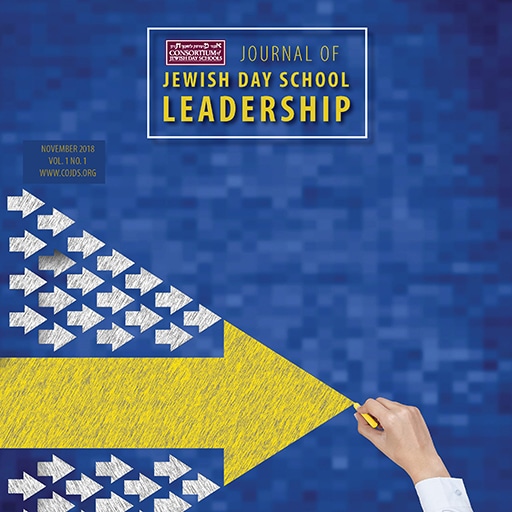
Seeking Submissions
January 3, 2022
CoJDS’ Curriculum Development–A Closer Look
January 17, 2022by Rabbi Shmuel Stein
In my conversations with principals and roshei mosdos, it seems clear that concern over kria in our schools seems to have escalated and has become one of the most crucial educational issues which needs to be addressed. kria has been put on the front burner of many mosdos and is getting more attention than it has in the past. Although it can be debated whether this issue is a new one or an old one that went unrecognized, today it is one that must be addressed effectively.
There are many reasons why it is essential for every student to be accurate, fluent, and comfortable when reading Hebrew. An obvious reason is to be able to daven and recite tehillim properly. Another basic reason is that learning texts such as chumash, mishnayos, gemara, rishonim, acharonim, etc. requires a student to know how to read.
In addition, when a student does not read Hebrew well his self-confidence suffers. He begins each lesson of chumash and mishnayos with a handicap and struggles to keep up with the rest of the class. Deficient reading ability means that the child will feel battered and have a miserable school experience, particularly if he is weak in other areas of learning as well.
Yet there is something that is perhaps even more significant and of concern. Research shows that a person who is not fluent in a language lacks a sense of belonging. A child who cannot read Hebrew has a hard time feeling connected to the schoolwork he is learning, and even more upsetting, he feels disconnected from yiddishkeit. In my conversations with roshei mosdos, they have revealed that many of those who end up in yeshivos for “off the derech” children are children who suffer from weakness in kria.
The fact that kria is so vital for our students’ wellbeing creates an obligation for us, as principals and roshei mosdos, to create a system for kria that will effectively teach every child in our mosdos how to read fluently and accurately so that they can daven well, can learn, feel confident, enjoy their school experience, and develop a sense of connectedness to yiddishkeit.
When I was given the task of creating a kria program for my school I was determined to build the best kria program that I could. My journey led me to schools throughout America, meeting leading roshei mosdos, principals, teachers, and kria pros who were gracious enough to give me hours of their time and share with me their wisdom and experiences about improving kria in schools. In this essay I attempt to present a distillation of the ideas that I have gleaned from these experts and propose a 5-step program that every school could implement.
The Challenges of Teaching Kria
We are faced with two distinct challenges which make it difficult to ensure that every student who passes through our mosad reads Hebrew accurately and fluently:
- Kria is taught over several years. This makes it difficult to ensure that all the students have mastered the necessary skills to read properly, because there is ambiguity or misunderstanding about when and how the subject has been taught. Teachers may assume that skills will be taught by the teacher the next year, but the teacher next year teacher often assumes that they were already taught the previous year. Also, because kria is taught over several years, there is always at least one long summer break when a student can easily forget the kria skills that he or she has just partially acquired. The following year, when the teacher begins teaching kria, the students start at a much lower point than they ended the year before. A clear and effective curriculum, which clearly defines when and how the different parts of kria are taught, can address these issues.
- Our students typically do not practice kria in their daily lives. Even if we are successful and teach kria well, students need to practice or they can quickly lose this skill. Since in chutz la’aretz we do not typically read in Hebrew, it is difficult to give our students effective practice in kria. We do daven and learn in Hebrew, but students are generally not practicing kria during these times, just repeating words that are familiar or that they have just heard from their teachers. We need to provide our students with time during the day to actually practice reading.
The 5-Step Kria Program
There are five steps that are necessary for perfecting kria in our schools. These steps create a structure for perfecting a school’s kria program and still leave room for each school to create their own unique kria program to fit their school’s needs. When these five steps are followed every student can graduate from elementary school reading Hebrew well.
Step 1: Curriculum
The first step in building a successful kria program is to ensure that the school has a solid kria curriculum that will enable the largest number of students to learn how to read Hebrew. We are looking for a kria curriculum that is clear, systematic, and understandable that allows us to reach as many students as possible.
There are some talented teachers who can “invent” their own effective methods to teach kria, but most teachers would be better off adopting a well-researched and proven curriculum than inventing their own method. These methods serve as a structure and basis for teaching kria and are intended to leave room for personalization, so there need not be a concern that teachers will feel stifled.
The skill of reading Hebrew is made up of four components, and a good kria curriculum addresses all four:
- Osios
- Nekudos
- Blending (osios with nekudos)
- Syllabication (learning to break Hebrew words into syllables)
As with any curriculum implementation, teachers must be trained. If the teachers do not understand the method of the curriculum that their school adopts, they will be ineffective. What ends up happening is that the teachers teach page after page from a textbook without really understanding the method or goal of the curriculum. We cannot expect the students to obtain a clear understanding of kria if the teachers themselves are not crystal clear about the method they are using to teach kria. Therefore, it is imperative for the teachers to be trained in the method that the school will choose to use.
Step 2: Early Intervention
The second step to building a system that allows each student to perfect his kria is providing early intervention for weaker students. As we teach kria there will inevitably be students who need help along the way to ensure that they can keep up with the rest of the classroom. In public education, early intervention is thought to be a more efficient and effective way of supporting literacy than waiting until students are older and problems become apparent. Likewise, we must provide remediation early on while kria is first being taught.
With early help to ensure that all children can keep up with the pace of the rest of the class, bigger issues can be avoided down the road. If we do not provide the remediation when kria is being taught and we wait until after we finish kria, it is difficult to get these children back on track and uproot poor reading habits later on when their class moves onto other skills (e.g., chumash and mishnayos). Even if we are successful in teaching them how to read Hebrew in later years, it may not become second nature to them as it could have been had they learned it early on with the rest of their class, and it is likely that they will not be as fluent as their peers.
Furthermore, early intervention will prevent two or three years of suffering for these children; years when their peers learn to read while they, despite trying their hardest, experience frustration and feelings of inadequacy. These feelings often lead to behavioral issues. Providing early intervention is the quintessential “chanoch l’nar al pi darko,” where we look out for every child’s needs.
Three Kinds of Readers
Before we get to Step 3, it’s worthwhile to address that in most classes, three types of readers become recognizable: the strong readers, the average readers, and the weak readers. The first group are the natural readers who will learn to read well regardless of curriculum or teachers. We do not need to be worried about their kria skills at all. (In fact, they will be helpful in ensuring that the rest of the students will become excellent readers, as we will discuss later.) The second group are those who pick up kria but will have challenges holding on to their kria skills if they do not receive sufficient kria practice throughout elementary school. Step 3 will describe the approach to support this group. The third group, the weak readers, are those who naturally have a harder time learning the skills necessary to read Hebrew and become fluent in reading. This group has its unique challenges in kria that we must address. We will deal with them in Step 4.
Step 3: Effective In-Class Practice
As mentioned earlier, one of the challenges we face with teaching kria is that our students typically do not “read” Hebrew as a language. Here in chutz la’aretz, where street signs, cereal boxes, and books are all written in English, there is truly little natural kria practice that our children are exposed to. Even the learning and davening we do in school is more memorization, repetition, and chanting, than it is reading. This means that we need to create an effective way to practice kria in class.
Yet, there is a great challenge with providing effective kria practice. One approach for kria practice in the classroom is for the teacher to go around the room calling on one student at a time to read a pasuk or two, giving each student a chance to read. The advantage of this method is that the teacher has a chance to hear each student read and correct mistakes. However, this method is often not effective because each student does not get an opportunity to really practice reading for very long; perhaps he or she will read for only thirty seconds a day. This method may work as a daily evaluation but is surely not sufficient to provide the much-needed daily practice. Second, this method is often not practical because as one student reads, the other students in the class sit around idly. This ultimately leads to the teacher and students feeling that kria is “boring.”
A more effective way to ensure that each student gets enough kria practice is through a chavrusa-based method, which means that students are paired up (a stronger reader with a weaker one) and practice reading together. This is an excellent method that has been tried and has been successful for the practice of kria in the classroom for students in second to fifth grade.
Step 4: Effective Remediation
With the strong and average readers taken care of, let us turn our attention to the third group, the naturally weak readers. It is our responsibility as a school to be aware of each student and to make sure that none fall through the cracks and go unnoticed. We must ensure that we have an effective remedial method, one that can improve kria quickly and effectively, even for the weakest of kids. One such method is Rabbi Yaakov Kiwak’s method, which is lauded by many of the kria specialists to whom I have spoken. It is a clear and straight-forward method that I used over and over with startling results.
Just because a child needs remediation does not mean that he will need help for the rest of his elementary school years. A student with minor remediation needs should be back in the classroom after two months of extra help. A child with more serious needs may need six months to a year of help.
Typically, a child who finishes remediation and successfully learns the skills necessary for kria will still need months of practice to become fluent in reading. If he does not get this practice, he can quickly lose the skills that he gained. Yet giving each of these children months of practice can take a big toll on the resources of the school. This is where our built-in review program in grades 2 through 5 (Step 3) provides another great benefit. Once these weaker readers learn the skills of kria they can get their practice in the classroom itself! We simply pair up these weaker readers with stronger readers (group one) in the class and they get 10-15 minutes of practice each day, allowing the resource room to service other students, and taking the stress out of continuously practicing with these children. It also makes the resource process much easier and tolerable for the child because he can return sooner to the classroom.
Step 5: Tracking Kria with Data-Based Methods
The only sure way to really track a school’s progress in kria is by doing regular schoolwide assessments. It may seem that kria is improving but until we evaluate, we cannot know for sure that we are really doing a great job. We need to be courageous to make these evaluations because it exposes how we are really doing. It easier to just assume that we are doing well, but it is our responsibility as a school to get the real facts. We must perform these evaluations both when kria is taught and when kria is practiced throughout elementary school.
We must test for three components:
- Accuracy: The number of mistakes a child makes when reading
- Speed: The number of syllables the child reads per minute
- Fluency: The fluidity of the child’s reading; is his reading choppy or smooth
Every Child a Great Reader
The most integral and basic skill that we must give to our students in elementary school is kria. We must make sure that we give every child the opportunity to know how to read Hebrew. This goal is truly attainable. Nevertheless, to ensure success a mosad must make a strong effort and make “a big deal” about kria in their school. To accomplish this goal, it would seem imperative that the school hire a rebbi or morah responsible for accomplishing this, to oversee the entire school’s five- to six-year kria program. This requires money and effort, but it produces successful readers, prepares our students for the other limudim, and serves as a source of pride for our school. An elementary school principal remarked to me, “My goal used to be for every child to know how to learn gemara, then I lowered my expectations to chumash, now I’ve lowered it even further so that every child should know kria, but even this is a challenge.” The truth is: It is a challenge! But with a good system and dedicated rebbeim and moros, we daven that HaKadosh Baruch Hu should give us siyata dishmaya to accomplish our goals.
Rabbi Shmuel Stein is director of kria at Yeshivas Toras Chaim Toras Emes in North Miami Beach, Florida. Rabbi Stein is trained as a kria specialist and has spent years observing kria programs around the country to develop a method to perfect a school’s kria. He consults numerous schools on how to perfect their kria program so that every student is fluent. He is the author of the book “The Five Steps to Perfecting a School’s Kria Program,” upon which this article is based. Contact Rabbi Stein at [email protected].

